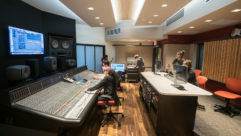
The Democratization Of AV Control Systems
Open-architecture products seek to challenge proprietary systems’ dominance with simple-to-use, low-cost device control solutions.
As pro AV continues to merge with the broader IT technology spectrum, a number of IT-centric suppliers have emerged to compete in what has traditionally been the industry’s most specialized product genre of all — control systems. Currently, the vast majority of AV systems are controlled by propriety hardware and software provided by either Richardson, TX-based AMX or Rockleigh, NJ-headquartered Crestron. However, an emerging field of both hardware- and software-based device-control solutions — all structured on simple open-architecture programming — is seeking to gain a toe-hold in the market.
Early players
One example is the just-released atmospherics 2.0, a software application published by San Francisco-based Cloud Systems. Running on any Windows or Linux platform, and designed so that the PC becomes the AV-control processor, atmospherics coordinates communication with any RS232, RS422, IR, GPIO, or IP device.
The flexible Java- and Flash-based program requires no specialized programming skill to set up. It needs no proprietary hardware, and its user control interface can be supplied by a variety of widely available devices, including PDAs, tablet PCs, and standard web browsers. “One of the things a software control solution does is simplify the cost equation,” says Cloud Systems Business Development Director Matt Barmash. “The question of what it’s going to cost to add a few more AV-equipped rooms becomes a very simple licensing equation. And software is ever-evolving, while hardware has an end date from the day it’s purchased. With atmospherics, I can get updates that are continually being driven by the market.”
Norcross, GA-based Simtrol estimates that its control software, OnGoer, can cut the integration price tag in half for a corporate meeting room featuring 10 AV devices controlled by an $1,800 proprietary processor and an $8,000 proprietary touchpanel. That estimate — detailed on Simtrol’s website touting the motto “Bringing AV and IT together” — entails a $3,400 OnGoer software license, a $680 off-the-shelf touchpanel, a $460 Dell PC, a $300 IR/IO box, and a $125 serial port expansion module.
“You’re talking about commodity-level, off-the-shelf hardware vs. proprietary hardware,” says Mike Miller, chief technology officer for Simtrol, whose company also supplies the system-monitoring solution OnGuard, which is positioned to compete with AMX’s MeetingManager and Crestron’s RoomView.
Not all open-architecture AV control solutions are software based, however. Targeted at budget-conscious end-users seeking to control less complex AV systems, Hudson, WI-based Calypso Control Systems sells open-architecture hardware including IO modules, processors, and wireless remotes.
Calypso control hardware is based on a protocol called c-Link that requires no specialized programming skill —not even Java or Flash. Calypso controllers come with a built-in web server that provides a simple walk-through set-up process and requires no code-writing. Essentially, all a Calypso “programmer” has to do is align a database of pre-programmed device-control macros to any number of third-party software interfaces. For example, hyperlinks within a PowerPoint presentation can be set to trigger macros that automatically turn on a DVD player and LCD projector while dimming the lights.
“When we’re talking about a small room solution, the hardware isn’t really the determining factor in terms of cost — it’s the overall project cost and how much flexibility you have,” says Calypso President David Parish. “In the world of traditional AV system control, you need to be a trained programmer — and that’s what drives up complexity and cost. Typically, it would take a $125-an-hour programmer to set it up, but in Calypso’s world, you can take a technician who’s making $25 an hour to set this all up.”
Little market penetration
While these aforementioned open-architecture solutions seem to have the potential to revolutionize the AV industry on paper — transforming a business long-rooted in AMX and Crestron sales and certification — their market share remains almost nil. Most of the suppliers are just getting started in the pro AV business. In fact, none of those interviewed for this article was able to quote substantive sales figures.
“We’re just getting going,” concedes Parish, noting that Calypso only introduced its AV line at InfoComm last year. “But our adoption rate has been good.”
Both AMX and Crestron defend their market position against emerging open-architecture software competition by, first and foremost, citing platform stability: “We have control processors that have been booted up for five years without crashing,” says AMX Vice President of Product Management Robert Noble, noting that any PC-based application is more likely to lock up.
Open-architecture control suppliers such as Calypso are seeking distribution through standard AV dealer and integrator channels by targeting the lower end of the market.
“We know there are projects where the rent isn’t big enough to support (using proprietary control technology),” notes Parish, who views Calypso as “complementary” to AMX and Crestron and not in direct competition.
As a real-world example, he cites K-12 classrooms. “There are thousands of these classrooms out there, but the bad news is that the margins are very low, and dealers and integrators need a different kind of solution than what’s out there right now to address that market,” he says. “With Calypso, we can put in a single $395 network-based controller and take advantage of the computer in each classroom for all the user interfaces.”
Still, such appeals have found little traction among AV dealers and integrators so far.
Jeff Beam, an AMX-certified programmer working for Niles, MI-based TPC Technologies, says he’s looked at open-architecture software control solutions, including OnGoer, for the budget-conscious K-12 market he services, but he doesn’t see any real cost savings. Any benefit from replacing a proprietary control processor with a PC is all — or partly — negated by the need for port expansion, he says. “Sure, I can get a PC cheaper than a $1,000 AMX controller, but what is IO going to cost me? If I need eight to 16 serial ports on a PC, I’m going to have to buy a terminal adapter, and that’s going to cost several hundred dollars,” Beam explains.
Even for less complex AV systems, with customers requesting more customization than ever, Beam is also skeptical as to whether macro-based software solutions are robust enough to challenge AMX and Crestron products.
“There’s always a place for the non-technical user, but there’s a point at which you’re limited by a simple programming interface, and you need to get down into the code to make things work the way you really want them to,” Beam says.
OPEN-ARCHITECTURE AT A GLANCE
Company: Calypso Control Systems
AV control solutions: Calypso sells open-architecture hardware including the ION-e, a device controller designed for common classroom and other education AV applications. Equipped with an assortment of serial, IR, and relay inputs and outputs, the ION-e features a database of pre-programmed device control macros that can be set up so that they’re triggered by user interfaces in a wide variety of Windows and Macintosh applications, as well as external control devices like handheld PDAs.
Pricing: Calypso device controllers (hardware) range in price from $395 to $795 MSRP.
Contact: 715-381-9646; www.calypsocontrol.com
Company: Cloud Systems
AV control solutions: atmospherics 2.0 operates on Windows and Linux operating systems, and coordinates communication between any RS232, RS422, IR, GPIO, or IP device. Its object-based user interface requires no proprietary hardware or programming certifications, and it allows an AV system to be handled by any network-enabled control device.
Pricing: Contact supplier.
Contact: 800-806-5567; www.cloudsystems.com
Company: Simtrol Inc.
AV control solutions: OnGoer is PC-based general-purpose device control software designed to run on Windows 2000, Windows 2003, and Windows XP platforms. Requiring no proprietary hardware, OnGoer controls AV devices using a variety of interfaces, including TCP/IP, IR, relays, serial (RS232, RS422, and RS485), Lanc, and USB. The solution supports both Flash and Visual Basic programming environments and includes a database of control macros for popular AV devices. Simtrol also sells the complementary system-monitoring solution OnGuard, which allows operators from remote locations to view real-time system and device status on any control system, including AMX and Crestron.
Pricing: Simtrol software is priced on a per-device basis: OnGoer starts at $360 for one to five devices and scales down to $300 for 100 and more.
Contact: 800-423-0769; www.simtrol.com
Company: Stardraw.com
AV control solutions: London-based Stardraw.com claims its Stardraw Control software can “control any product from any manufacturer over any protocol including TCP/IP, IR, serial RS232, DMX, UDP, EtherSound, and CobraNet” without the user having to write any code. No proprietary hardware is required.
Pricing: Stardraw Control has a flat licensing fee of $500 per project.
Contact: 866-978-0906; www.stardraw.com
There’s also a limited level of customization and integration in what you can do with a macro-based software control system,” adds Crestron Spokesman Jeff Singer. “You can send data streams and ask it to do stuff, but when you’re talking about high levels of integration and customization, it’s not going to be robust enough,” he says.
Cloud Systems’ Barmash doesn’t totally disagree. “The great thing about proprietary solutions is, you can generally program something exactly the way you want to with them,” he says. “But at the same time, there are some things that can be done without programming, and that’s where open architecture has the advantage.”
Vying for control
And as far as simplicity goes, both AMX and Crestron sell software applications that automate the process of code-writing. And both companies have incorporated various forms of plug-and-play interoperability over the years into their solutions that have made them seem not so proprietary. AMX, for example, now touts more than 50 AV manufacturer partners in its Dynamic Device Discovery Protocol initiative, which establishes a common framework for these companies to embed AMX control code capabilities into their new products. Meanwhile, Crestron has had very similar programs for some time.
“We have an industry partnership program that’s second to none,” notes Singer, who bristles at the notion that his company manufactures segregated, proprietary solutions. “We work with the engineers of hundreds of manufacturers to ensure the new products they design work with Crestron.”
Aside from how their products will match up against AMX and Crestron in various vertical markets once they’re more fully deployed, proprietors of enterprise IT-style control solutions say they’re being stymied from entry into the pro AV market mainly by a desire to maintain the status quo.
“We do find that dealers are defensive based on the investments they’ve made in other control systems,” Parish says. “We have better luck with distributors who are IT-focused right now.”
One of the products from San Francisco-based Cloud Systems is atmospherics, a server-based solution that uses industry standard protocol (Java, XML, and Flash) and requires no proprietary hardware. This open architecture software runs under both Linux and Windows operating systems and coordinates communication between any RS232, RS422, IR, GPIO, or IP device.
For a genre of products perhaps more rooted in an enterprise IT model than traditional pro AV, that route might make sense. Simtrol’s OnGoer, for example, is distributed through Niantic, CT-based Telaid Industries, a company rooted in IT cabling, that directs the bulk of its marketing toward end-users. In fact, Parish argues that the advent of easy-to-program, open-architecture control solutions is natural for a pro AV industry that’s moving toward customized control solutions and easy-to-operate push-button environments — and one that’s transitioning into mainstream markets.
“Up until relatively recently, pro AV was a specialty industry that sold to specialty customers with unique needs,” he explains. “Broad-based standards and open architectures don’t really exist in a world like that, and you could get away with specialty skill sets and higher prices. Specialty buyers would tolerate that because they had few options. But that’s really changed over the last few years. I would argue that AV has become a mainstream communications tool, and it’s transitioning from specialty customers to mainstream customers, and mainstream buyers don’t tolerate complex solutions.”
For his part, Barmash sees the emergence of open-architecture AV control as ground zero to the larger convergence issue and the shifting of purchasing power into the hands of the IT manager. “The fact is, the decision-makers are changing,” he says. “And it helps if you’re selling technologies that are blessed by IT. Since we’re running in the current IT environment, we’ll be embraced by that environment.”
Even though these emerging open-architecture solutions have yet to capture the imaginations of the world’s IT managers, the convergence-leery pro AV industry is concerned about ceding control of their systems to the IT world going forward. In late August, for example, members of the Cedar Rapids, IA-based industry organization National Systems Contractors Association (NSCA) met in Chicago to discuss the issue of open-architecture control systems and what effect they could have on the business. “We’re going to have people from Crestron and AMX talk about how they defend their position in the industry,” said NSCA Executive Director Chuck Wilson, three days before the event. “This is a sensitive subject for us right now.”
Daniel Frankel is a freelance writer based in Los Angeles. He can be reached at [email protected].










